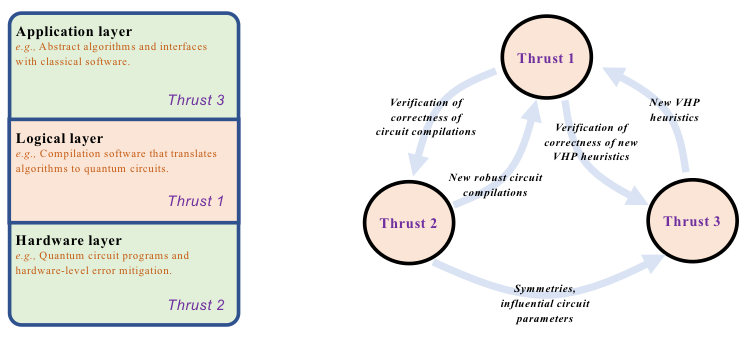Quantum technologies, especially quantum computers, show great promise for revolutionizing high-performance computing and simulation. As prototype quantum computers come online, it is becoming clear that obtaining useful output from such devices will require layers of sophisticated classical software that provide interpretation and analysis of the quantum computer’s state and output. OVER-QC will develop critical components in this “software stack” with a particular focus on enabling near-term Noisy Intermediate-Scale Quantum (NISQ) technologies. We have identified three critical needs for near-term quantum computing platforms, and the project is structured around three thrusts that address these needs:
Thrust 1: develop capabilities to verify and certify translations of abstract quantum algorithms to quantum circuit programs;
Thrust 2: develop tools to identify the reliable information that can extracted from near-term devices in the absence of fault-tolerant operation;
Thrust 3: develop interfaces for variational hybrid quantum-classical processors (VHPs) that enable applications by connecting classical algorithms to quantum co-processors.
The following figure illustrates how these thrusts fit into the conventional picture of a quantum computing software stack, and how the outcomes of each thrust inform the other ones.

A key aspect of OVER-QC is that we will not only develop software tools targeted for use with near-term quantum computers, but we will also invest significant effort into understanding the reliability and computational power of near-term devices. In particular, we will address two key questions, (1) is it possible to engineer the dynamics of NISQ devices so that they have robust algorithmic properties in the presence relevant error models, and (2) what is the real computational advantage posed by algorithms running on NISQ devices, and specifically, what level/type of noise permits some computational advantage over classical algorithms and heuristics for the same tasks. Answering these questions will not only guide the development of quantum algorithms tailored to near-term quantum devices, but it will also reveal the fundamental computational potential of non-fault-tolerant quantum devices.
The project’s members are from Sandia National Laboratories, Los Alamos National Laboratory, Dartmouth College and University of New Mexico.
The four-year project started in October 2018.
OVER-QC is closely linked to its sister project QOALAS, funded under the Quantum Algorithm Teams program of DOE/ASCR.
Other DOE/ASCR projects the OVER-QC team members collaborate with are:
1. The Quantum Performance project led by the Quantum Performance Laboratory at Sandia.
2. QAT4Chem led by Lawrence Berkeley National Lab.
3. Heterogeneous Digital-Analog Quantum Dynamics Simulations (HDAQDS) led by Oak Ridge National Lab.
4. STAQC led by Oak Ridge National Lab.